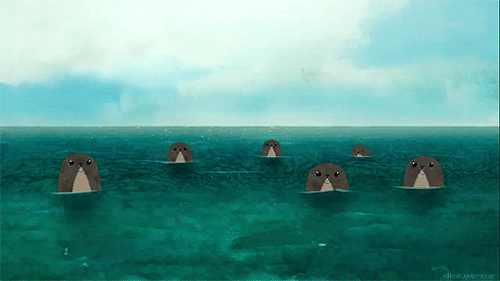
Been feeling kind of blue lately, so I tried to make something cute to counteract it. A little Otter Tea Time.

Been feeling kind of blue lately, so I tried to make something cute to counteract it. A little Otter Tea Time.
Russian Sledgessuspiria autoshare
okay I'll stop now
Russian Sledgesbarbara stanwyck's legs autoshare
Russian Sledgessuspiria autoshare


But a lot of strange things are happening.
Suspiria (1977)
Russian SledgesI like gary cooper because he's dreamy
there, I said it
Russian Sledgesnight of the hunter autoshare
Russian SledgesI should probably see this







Song of the Sea [d: Tomm Moore, 2014]
Russian Sledges'But recent studies of the DNA of pre-agricultural hunters from Europe reveal that people had extra copies of amylase genes long before they started farming. Dr. Thomas and his colleagues propose that the invention of fire, not farming, gave rise to the need for more amylase. Once early humans started cooking starchy foods, they needed more amylase to unlock the precious supply of glucose. Mutations that gave people extra amylase helped them survive, and those mutations spread, thanks to natural selection. That glucose, Dr. Thomas and his colleagues argue, provided the fuel for bigger brains.'
Russian Sledges'And I heard another from the altar saying, “Even so, Lord God Almighty, true and bitchin’ are Your judgments.”'
Previously: The Unchill Bible.
Genesis 7:1
Then the Lord said to Noah, “Come into the ark, you and all your household, because I have seen that you are bitchin' before Me in this generation.
Genesis 18:23-24
And Abraham came near and said, “Would You also destroy the bitchin' with the wicked? Suppose there were fifty bitchin' within the city; would You also destroy the place and not spare it for the fifty bitchin' that were in it?"
Read more Bible Verses Where The Word “Righteous” Has Been Replaced By “Bitchin'” at The Toast.
Russian Sledges'I physically recoiled during the introductory session when Kerry Vaughan, one of the event's organizers, declared, "I really do believe that effective altruism could be the last social movement we ever need." In the annals of sentences that could only be said with a straight face by white men, that one might take the cake.'

"There's one thing that I have in common with every person in this room. We're all trying really hard to figure out how to save the world."
The speaker, Cat Lavigne, paused for a second, and then she repeated herself. "We're trying to change the world!"
Lavigne was addressing attendees of the Effective Altruism Global conference, which she helped organize at Google's Quad Campus in Mountain View the weekend of July 31 to August 2. Effective altruists think that past attempts to do good — by giving to charity, or working for nonprofits or government agencies — have been largely ineffective, in part because they've been driven too much by the desire to feel good and too little by the cold, hard data necessary to prove what actually does good.
It's a powerful idea, and one that has already saved lives. GiveWell, the charity evaluating organization to which effective altruism can trace its origins, has pushed philanthropy toward evidence and away from giving based on personal whims and sentiment. Effective altruists have also been remarkably forward-thinking on factory farming, taking the problem of animal suffering seriously without collapsing into PETA-style posturing and sanctimony.
Effective altruism (or EA, as proponents refer to it) is more than a belief, though. It's a movement, and like any movement, it has begun to develop a culture, and a set of powerful stakeholders, and a certain range of worrying pathologies. At the moment, EA is very white, very male, and dominated by tech industry workers. And it is increasingly obsessed with ideas and data that reflect the class position and interests of the movement's members rather than a desire to help actual people.
In the beginning, EA was mostly about fighting global poverty. Now it's becoming more and more about funding computer science research to forestall an artificial intelligence–provoked apocalypse. At the risk of overgeneralizing, the computer science majors have convinced each other that the best way to save the world is to do computer science research. Compared to that, multiple attendees said, global poverty is a "rounding error."
I identify as an effective altruist: I think it's important to do good with your life, and doing as much good as possible is a noble goal. I even think AI risk is a real challenge worth addressing. But speaking as a white male nerd on the autism spectrum, effective altruism can't just be for white male nerds on the autism spectrum. Declaring that global poverty is a "rounding error" and everyone really ought to be doing computer science research is a great way to ensure that the movement remains dangerously homogenous and, ultimately, irrelevant.
/cdn0.vox-cdn.com/uploads/chorus_asset/file/3947916/Massive_Impact.png)
An artist's concept of an asteroid impact hitting early Earth. Just one of many ways we could all die!
EA Global was dominated by talk of existential risks, or X-risks. The idea is that human extinction is far, far worse than anything that could happen to real, living humans today.
To hear effective altruists explain it, it comes down to simple math. About 108 billion people have lived to date, but if humanity lasts another 50 million years, and current trends hold, the total number of humans who will ever live is more like 3 quadrillion. Humans living during or before 2015 would thus make up only 0.0036 percent of all humans ever.
The numbers get even bigger when you consider — as X-risk advocates are wont to do — the possibility of interstellar travel. Nick Bostrom — the Oxford philosopher who popularized the concept of existential risk — estimates that about 10^54 human life-years (or 10^52 lives of 100 years each) could be in our future if we both master travel between solar systems and figure out how to emulate human brains in computers.
Even if we give this 10^54 estimate "a mere 1% chance of being correct," Bostrom writes, "we find that the expected value of reducing existential risk by a mere one billionth of one billionth of one percentage point is worth a hundred billion times as much as a billion human lives."
Put another way: The number of future humans who will never exist if humans go extinct is so great that reducing the risk of extinction by 0.00000000000000001 percent can be expected to save 100 billion more lives than, say, preventing the genocide of 1 billion people. That argues, in the judgment of Bostrom and others, for prioritizing efforts to prevent human extinction above other endeavors. This is what X-risk obsessives mean when they claim ending world poverty would be a "rounding error."
/cdn0.vox-cdn.com/uploads/chorus_asset/file/3947886/11036955_939393542769347_976613789732206331_o.jpg)
From left: Daniel Dewey, Nick Bostrom, Elon Musk, Nick Soares, and Stuart Russell.
There are a number of potential candidates for most threatening X-risk. Personally I worry most about global pandemics, both because things like the Black Death and the Spanish flu have caused massive death before, and because globalization and the dawn of synthetic biology have made diseases both easier to spread and easier to tweak (intentionally or not) for maximum lethality. But I'm in the minority on that. The only X-risk basically anyone wanted to talk about at the conference was artificial intelligence.
The specific concern — expressed by representatives from groups like the Machine Intelligence Research Institute (MIRI) in Berkeley and Bostrom's Future of Humanity Institute at Oxford — is over the possibility of an "intelligence explosion." If humans are able to create an AI as smart as humans, the theory goes, then it stands to reason that that AI would be smart enough to create itself, and to make itself even smarter. That'd set up a process of exponential growth in intelligence until we get an AI so smart that it would almost certainly be able to control the world if it wanted to. And there's no guarantee that it'd allow humans to keep existing once it got that powerful. "It looks quite difficult to design a seed AI such that its preferences, if fully implemented, would be consistent with the survival of humans and the things we care about," Bostrom told me in an interview last year.
This is not a fringe viewpoint in Silicon Valley. MIRI's top donor is the Thiel Foundation, funded by PayPal and Palantir cofounder and billionaire angel investor Peter Thiel, which has given $1.627 million to date. Jaan Tallinn, the developer of Skype and Kazaa, is both a major MIRI donor and the co-founder of two groups — the Future of Life Institute and the Center for the Study of Existential Risk — working on related issues. And earlier this year, the Future of Life Institute got $10 million from Thiel's PayPal buddy, Tesla Motors/SpaceX CEO Elon Musk, who grew concerned about AI risk after reading Bostrom's book Superintelligence.
And indeed, the AI risk panel — featuring Musk, Bostrom, MIRI's executive director Nate Soares, and the legendary UC Berkeley AI researcher Stuart Russell — was the most hyped event at EA Global. Musk naturally hammed it up for the crowd. At one point, Russell set about rebutting AI researcher Andrew Ng's comment that worrying about AI risk is like "worrying about overpopulation on Mars," countering, "Imagine if the world's governments and universities and corporations were spending billions on a plan to populate Mars." Musk looked up bashfully, put his hand on his chin, and smirked, as if to ask, "Who says I'm not?"
Russell's contribution was the most useful, as it confirmed this really is a problem that serious people in the field worry about. The analogy he used was with nuclear research. Just as nuclear scientists developed norms of ethics and best practices that have so far helped ensure that no bombs have been used in attacks for 70 years, AI researchers, he urged, should embrace a similar ethic, and not just make cool things for the sake of making cool things.
/cdn0.vox-cdn.com/uploads/chorus_asset/file/2906340/shutterstock_169002578.0.jpg)
Note: not what the Doom AI will look like.
What was most concerning was the vehemence with which AI worriers asserted the cause's priority over other cause areas. For one thing, we have such profound uncertainty about AI — whether general intelligence is even possible, whether intelligence is really all a computer needs to take over society, whether artificial intelligence will have an independent will and agency the way humans do or whether it'll just remain a tool, what it would mean to develop a "friendly" versus "malevolent" AI — that it's hard to think of ways to tackle this problem today other than doing more AI research, which itself might increase the likelihood of the very apocalypse this camp frets over.
The common response I got to this was, "Yes, sure, but even if there's a very, very, very small likelihood of us decreasing AI risk, that still trumps global poverty, because infinitesimally increasing the odds that 10^52 people in the future exist saves way more lives than poverty reduction ever could."
The problem is that you could use this logic to defend just about anything. Imagine that a wizard showed up and said, "Humans are about to go extinct unless you give me $10 to cast a magical spell." Even if you only think there's a, say, 0.00000000000000001 percent chance that he's right, you should still, under this reasoning, give him the $10, because the expected value is that you're saving 10^32 lives.
Bostrom calls this scenario "Pascal's Mugging," and it's a huge problem for anyone trying to defend efforts to reduce human risk of extinction to the exclusion of anything else. These arguments give a false sense of statistical precision by slapping probability values on beliefs. But those probability values are literally just made up. Maybe giving $1,000 to the Machine Intelligence Research Institute will reduce the probability of AI killing us all by 0.00000000000000001. Or maybe it'll make it only cut the odds by 0.00000000000000000000000000000000000000000000000000000000000000001. If the latter's true, it's not a smart donation; if you multiply the odds by 10^52, you've saved an expected 0.0000000000001 lives, which is pretty miserable. But if the former's true, it's a brilliant donation, and you've saved an expected 100,000,000,000,000,000,000,000,000,000,000,000 lives.
I don't have any faith that we understand these risks with enough precision to tell if an AI risk charity can cut our odds of doom by 0.00000000000000001 or by only 0.00000000000000000000000000000000000000000000000000000000000000001. And yet for the argument to work, you need to be able to make those kinds of distinctions.
The other problem is that the AI crowd seems to be assuming that people who might exist in the future should be counted equally to people who definitely exist today. That's by no means an obvious position, and tons of philosophers dispute it. Among other things, it implies what's known as the Repugnant Conclusion: the idea that the world should keep increasing its population until the absolutely maximum number of humans are alive, living lives that are just barely worth living. But if you say that people who only might exist count less than people who really do or really will exist, you avoid that conclusion, and the case for caring only about the far future becomes considerably weaker (though still reasonably compelling).
/cdn0.vox-cdn.com/uploads/chorus_asset/file/3947944/ea_global.jpg)
Dylan Matthews
A view of Google's campus on the first day of the conference.
To be fair, the AI folks weren't the only game in town. Another group emphasized "meta-charity," or giving to and working for effective altruist groups. The idea is that more good can be done if effective altruists try to expand the movement and get more people on board than if they focus on first-order projects like fighting poverty.
This is obviously true to an extent. There's a reason that charities buy ads. But ultimately you have to stop being meta. As Jeff Kaufman — a developer in Cambridge who's famous among effective altruists for, along with his wife Julia Wise, donating half their household's income to effective charities — argued in a talk about why global poverty should be a major focus, if you take meta-charity too far, you get a movement that's really good at expanding itself but not necessarily good at actually helping people.
And you have to do meta-charity well — and the more EA grows obsessed with AI, the harder it is to do that. The movement has a very real demographic problem, which contributes to very real intellectual blinders of the kind that give rise to the AI obsession. And it's hard to imagine that yoking EA to one of the whitest and most male fields (tech) and academic subjects (computer science) will do much to bring more people from diverse backgrounds into the fold.
The self-congratulatory tone of the event didn't help matters either. I physically recoiled during the introductory session when Kerry Vaughan, one of the event's organizers, declared, "I really do believe that effective altruism could be the last social movement we ever need." In the annals of sentences that could only be said with a straight face by white men, that one might take the cake.
Effective altruism is a useful framework for thinking through how to do good through one's career, or through political advocacy, or through charitable giving. It is not a replacement for movements through which marginalized peoples seek their own liberation. If EA is to have any hope of getting more buy-in from women and people of color, it has to at least acknowledge that.
/cdn0.vox-cdn.com/uploads/chorus_asset/file/3947892/10987324_940120039363364_6003138536763824883_o.jpg)
Hanging out at EA global.
I don't mean to be unduly negative. EA Global was also full of people doing innovative projects that really do help people — and not just in global poverty either. Nick Cooney, the director of education for Mercy for Animals, argued convincingly that corporate campaigns for better treatment of farm animals could be an effective intervention. One conducted by the Humane League pushed food services companies — the firms that supply cafeterias, food courts, and the like — to commit to never using eggs from chickens confined to brutal battery cages. That resulted in corporate pledges sparing 5 million animals a year, and when the cost of the campaign was tallied up, it cost less than 2 cents per animal in the first year alone.
Another push got Walmart and Starbucks to not use pigs from farms that deploy "gestation crates" which make it impossible for pregnant pigs to turn around or take more than a couple of steps. That cost about 5 cents for each of the 18 million animals spared. The Humane Society of the United States' campaigns for state laws that restrict battery cages, gestation crates, and other inhumane practices spared 40 million animals at a cost of 40 cents each.
This is exactly the sort of thing effective altruists should be looking at. Cooney was speaking our language: heavy on quantitative measurement, with an emphasis on effectiveness and a minimum of emotional appeals. He even identified as "not an animal person." "I never had pets growing up, and I have no interest in getting them today," he emphasized. But he was also helping make the case that EA principles can work in areas outside of global poverty. He was growing the movement the way it ought to be grown, in a way that can attract activists with different core principles rather than alienating them.
If effective altruism does a lot more of that, it can transform philanthropy and provide a revolutionary model for rigorous, empirically minded advocacy. But if it gets too impressed with its own cleverness, the future is far bleaker.
Correction: This article originally stated that the Machine Intelligence Research Institute is in Oakland; it's in Berkeley.
Russian Sledgesvia Bunker.jordan

All images courtesy of Cambridge University Library
The earliest example of multicolor printing is now available for the public eye, digitally available through Cambridge University Library’s Digital Library site. The 17th century book, Manual of Calligraphy and Painting (Shi zhu zhai shu hua pu), is so fragile that it was previously forbidden to be opened, its contents a total mystery before its recent digitization.
The book was created in 1633 by Ten Bamboo Studio and is the earliest known example of polychrome xylography, invented by Hu Zhengyan. The technique, also referred to as douban, uses several printing blocks applied in succession with different inks to achieve the appearance of a hand-painted watercolor. The Cambridge site explains that the although the skill required to achieve such douban prints is admirable, the gradations of color within the book are what led to its reputation as “perhaps the most beautiful set of prints ever made.”
The manual contains eight categories showcasing birds, plumbs, orchids, bamboos, fruit, stones, ink drawings and miscellany. All of these sections of the manual are contained in the original “butterfly binding,” and has been identified to be the finest copy in the original binding by a leading scholar.
In addition to Shi zhu zhai shu hua pu, the library has also digitized other selections from its Chinese collections including the oracle bones (the earliest surviving examples of Chinese writing anywhere in the world), a Buddhist text dated between 1127 and 1175, and a 14th century banknote that threatens forgers with decapitation. (via Hyperallergic)












Russian Sledgesvia Bunker.jordan

The El Portal Fire burns on a hillside in the Stanislaus National Forest and Yosemite National Park on Sunday evening July 27, 2014. The community of El Portal was under a mandatory evacuation. By Tuesday the blaze had burned nearly 3,000 acres. Long exposure image.

The Etiwanda Fire burns shortly after dusk on April 30, 2014 in Rancho Cucamonga, CA. Long exposure image.
The news of deadly wildfires ravaging California has been as awe-inspiring as it is terrifying. Great swaths of forests, mountains, fields, and entire neighborhoods can be incinerated in moments leaving nothing unscathed. For the last few years, Los Angeles-based photographer Stuart Palley has been shooting these fires as they rage across Southern California as part of a series he calls Terra Flamma.
More than just capturing flames or firefighters, Palley focuses instead on the entire landscape surrounding each event. By utilizing long exposure techniques he incorporates trails of sparks, the lights of firefighting aircraft, and even the stars above to create images that speak more to the strange beauty of wildfires than simple editorial documentation.
Though Palley often jumps at the opportunity to photograph a fire at a moment’s notice, he’s also well prepared. He takes a number of precautions including completion of the US Forestry Service’s “Introduction to Wildland Fire Behavior” to better ensure his safety.
You can follow more of Palley’s work on Instagram. (via PetaPixel)

The French Fire burns overnight in the Sierra National Forest near the town of North Fork, CA on August 1st, 2014. The blaze was burning in steep, rugged, and remote terrain.

The Way Fire burns on August 19, 2014 in the Sierra National Forest near Kernville, CA overnight. Long exposure image.

The Meadow Fire burns overnight near Half Dome in Yosemite National Park early Monday September 8, 2014. As of Wednesday the fire had burned over 4,500 acres and was 10% contained. Long exposure image.

The Shirley Fire burns at night off of Old State Rd near Lake Isabella, CA while a helicopter circles overhead and crews work on a slopover. Long exposure image.

The Lake Fire burns in the San Bernardino National Forest Thursday June 18, 2015. By evening the fire burned over 10,000 acres and was 5% contained. The Lake Fire burns along its northern flank at night in the San Bernardino National Forest Late Thursday night.

The Lake Fire burns in the San Bernardino National Forest Thursday June 18, 2015. By evening the fire burned over 10,000 acres and was 5% contained. The Lake Fire burns along its northern flank at night in the San Bernardino National Forest Late Thursday night.

The Lake Fire burns in the San Bernardino National Forest Thursday June 18, 2015. By evening the fire burned over 10,000 acres and was 5% contained. The Lake Fire burns along its northern flank at night in the San Bernardino National Forest Late Thursday night.

The Lake Fire burns in the San Bernardino National Forest Friday June 19, 2015. By evening the fire burned over 13,000 acres and was 10% contained.

The Lake Fire burns in the San Bernardino National Forest Friday June 19, 2015. By evening the fire burned over 13,000 acres and was 10% contained.



“The meaning of this I can’t really say in one word… but one way to look at it is that I wanted to convey the sense of what it means to become an adult. In other words, there are no people with pure hearts in the world of adults. So, what would you do when you realize this? In other words, when you realize that the world of adults is a dirty one where no one with a pure heart can live, would you avoid it and remain as a child where you can live in a world of childish and beautiful dreams? Or, would you enter the adult world regardless even if you knew that it was not a pure world? So, which way are you going to choose?”
–kunihiko ikuhara, adolescence of utena commentary
Russian Sledgescornell ornithology library FAQ ftw
Russian Sledgesvia ThePrettiestOne

Jon Stewart concluded his generation-defining run on The Daily Show this past evening, Thursday, August 6th, and while many (many) people came to say goodbye, the emotional denouement belonged solely to Stephen Colbert.
And it was, appropriately, entirely a Lord of the Rings metaphor.
Watch the video of the beautiful, wonderfully nerdy send-off below.
Russian Sledgesvia overbey




Moscow Metro of 1930′s Soviet Union. Part III.
Russian Sledgesvia overbey




Moscow Metro of 1930′s Soviet Union. Part II.
Russian Sledgesaaaaaaaaa
Russian Sledgesvia rosalind
This coffee is so representative of its country of origin that I can practically taste the unique aspects of the culture of said country.
Russian Sledgeshmm
Russian Sledges<3
via saucie
Russian Sledgesvia Ibstopher
I am so psyched

THE first televised debate among the Republican candidates for president takes place in Cleveland on the evening of August 6th. Fox News is broadcasting the event, which, in a crowded field of runners, it has limited to ten participants based on their standing in the polls. Chris Christie and John Kasich just about made the cut, but Rick Perry, Bobby Jindal, Rick Santorum and the rest will have to settle for taking part in a separate televised meeting (dubbed by some as the losers’ forum) that will precede the big show. The debate is the first big opportunity for the candidates to present themselves on a national stage. They will hope to make a good impression and avoid the kind of gaffes (Rick Perry’s “Oops!” in the 2012 race) that can bring a campaign crashing to the ground.
Will Jeb Bush trip up over his position on the Iraq war? Can Marco Rubio rumble up the courage to speak for immigration reform? Will Donald Trump say something outrageously silly (of course he will). But before settling down to watch the fun, take some time to meet the candidates in our graphic